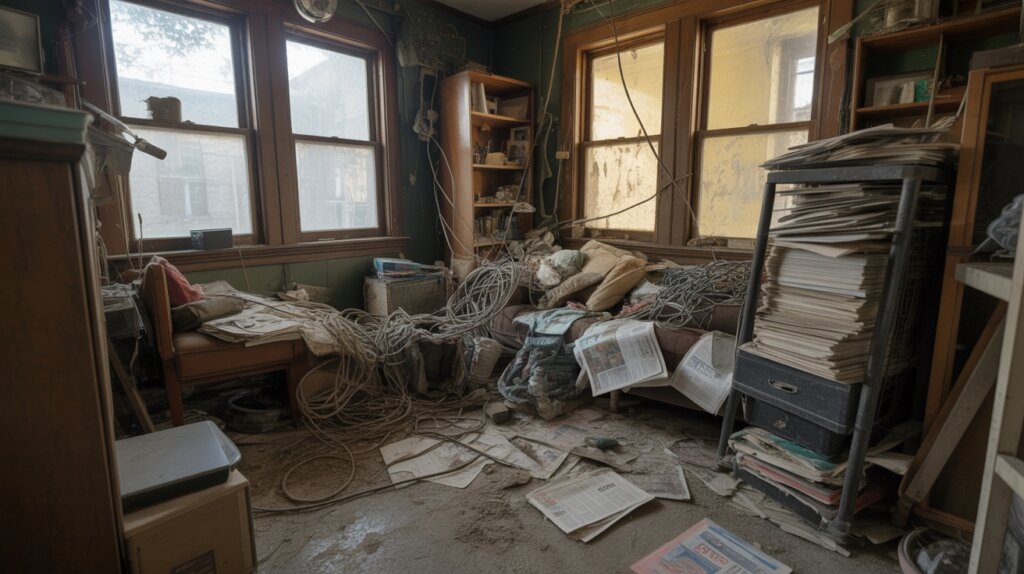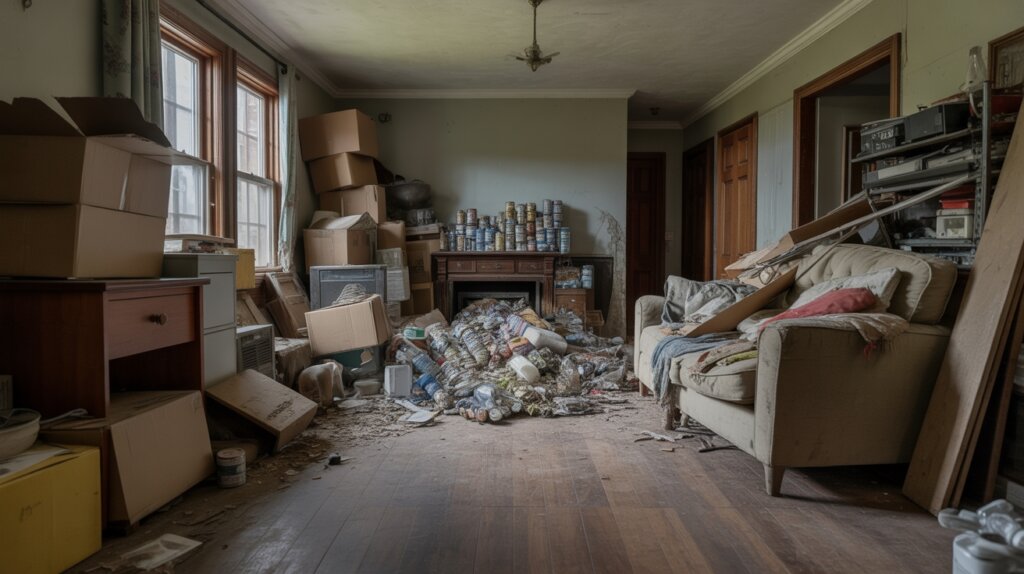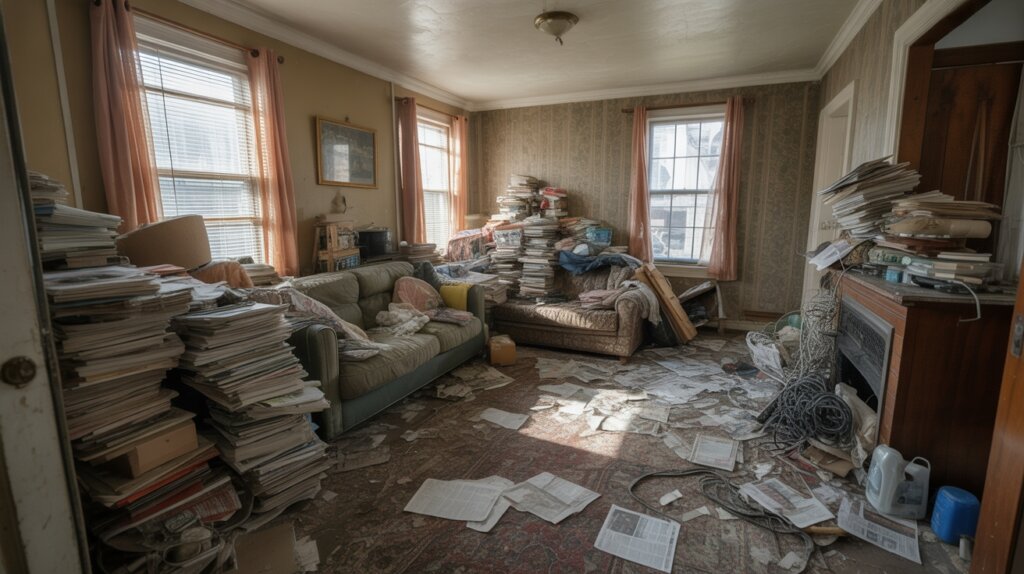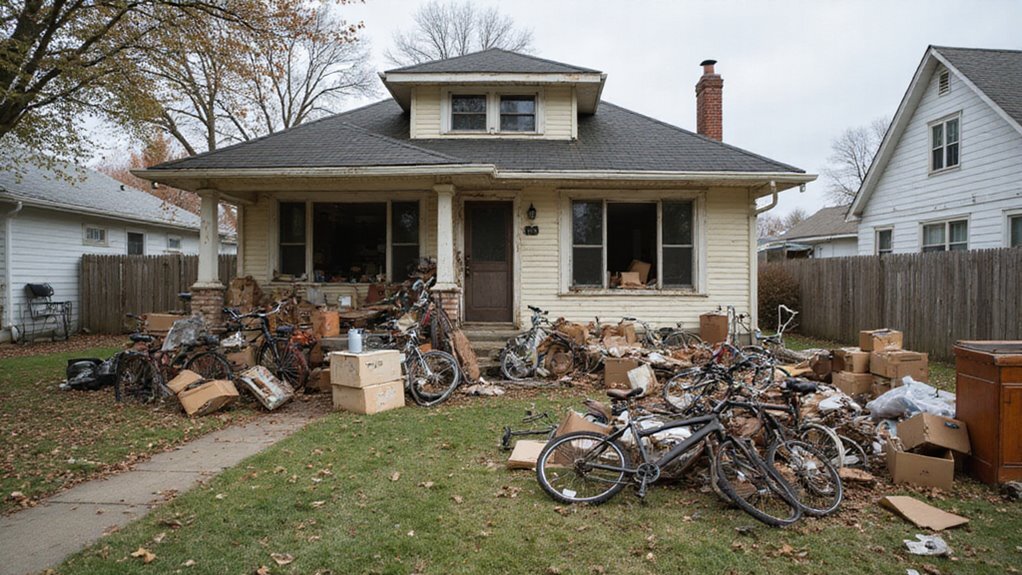Many people overlook how hoarding affects a property’s value. Hoarding is not just about messy rooms. It can make selling your home much harder and less profitable.
The clutter can hide major issues like mold or leaks. It also makes it tough for buyers and inspectors to see the real condition. This often leads to lower offers and longer selling times.
You can protect your investment by addressing hoarding before listing your property. Hoarding lowers property value by hiding problems, blocking access, and turning buyers away.
Simple steps can boost your home’s appeal and final sale price. This blog will guide you through practical solutions that can help restore your property’s value.
Key Takeaways
- Hoarding reduces property value by making spaces appear smaller, less functional, and less appealing to buyers.
- Severe clutter can hide structural damage, pests, and mold, leading to costly repairs and lower appraisal values.
- Hoarding increases health and safety risks, often violating local codes and resulting in fines or legal actions that decrease value.
- Difficulties with inspections and appraisals due to clutter can delay sales and reduce buyer trust, further lowering value.
- Neglected hoarding properties can impact neighborhood perception and property values, making nearby homes harder to sell.
Understanding Hoarding and Its Causes

Hoarding is not just being messy. It is a complex condition with many causes. Genetics, environment, and mental health all play a role. Studies show hoarding links to brain areas that handle decisions and emotions. If someone has experienced trauma, anxiety, or depression, they may be more likely to hoard. Research also shows up to 5% of people may have hoarding disorder. People with family members who hoard are at higher risk themselves.
If you want to help someone with hoarding, it is important to understand these factors. Addressing the psychological reasons is key to managing hoarding, not just removing clutter. Additionally, understanding the psychological factors can improve intervention strategies and support effective treatment. Recognizing these underlying causes can lead to more compassionate and effective support for individuals struggling with hoarding.
Common Signs of Hoarding in a Home
Hoarding in a home is more than just a messy space. It involves specific behaviors and patterns that go beyond simple clutter. Spotting these signs early can help you understand the real state of a home.
Hoarding often causes rooms to become unusable because items block access to furniture or appliances. Clutter can pile up so much that moving around or cleaning is difficult. If these conditions exist, the home may not function as intended.
People with hoarding disorder may keep bringing in unnecessary items, even if they have little or no value. They often feel strong emotional distress if asked to throw things away. Noticing these behaviors can help you decide if a property has a hoarding issue.
Additionally, excessive clutter can hinder proper safety inspections and conceal hazards such as structural damage or health risks, making it even more important to identify hoarding early. Recognizing clutter accumulation as a sign of hoarding can prompt timely intervention and proper handling during the sale process.
The Impact of Clutter on First Impressions

Clutter gives a bad first impression when people enter a home. It can make buyers and appraisers think the home is less valuable. A messy room looks smaller and less useful right away. Proper damage assessment can reveal underlying issues that might be overlooked when clutter is present. Buyers may not see the true potential of a home if clutter is present.
Appraisers might lower their estimates if they see mess, as it hints at poor care. Homes with clean, organized spaces usually sell faster and for more money. If you remove clutter, you can attract more buyers and get better offers. Clean homes usually spend less time on the market. First impressions matter, so keeping spaces tidy is important for selling success. Proper pricing strategies also depend on presenting a well-maintained property free of clutter to maximize appeal.
Structural Damage Linked to Hoarding
Hoarding can cause serious damage to a home’s structure. Too many belongings put stress on floors and walls. If you do not organize clutter, your home may need expensive repairs.
Heavy piles can make floors sag or collapse. Blocked vents from clutter trap moisture, which leads to mold and weakens walls. Hidden leaks or pests stay unnoticed under clutter and can cause rotting.
Blocked doors or windows make it hard to maintain your home. If you use proper storage and keep things organized, you can avoid these problems. Good organization helps protect your home’s value and structure.
Fire Hazards and Safety Concerns

You increase your property’s fire risk when hoarding leads to excessive combustible materials and obstructed emergency exits. Data from the National Fire Protection Association shows that cluttered homes can delay first responders, raising the likelihood of severe damage and injury.
These safety concerns don’t just threaten lives—they can also drive down property values in your area. Additionally, title issues related to hoarding can complicate property sales, further impacting value and marketability. To mitigate these risks, it is important to address legal obligations and ensure the property remains compliant with safety regulations.
Increased Combustible Materials
Hoarding increases the amount of combustible materials in a property. This raises the chance of a fire starting and spreading quickly. If a fire occurs, it can become severe much faster.
Excess paper, fabrics, and plastics all catch fire easily. Fire studies show homes with hoarding are up to five times more likely to have serious fires. These materials make it harder to escape or control the fire.
During inspections, officials look for common hazards. Accumulated paper and cardboard can ignite quickly. Blocked ventilation, overloaded outlets, and unsafe storage of flammable liquids also increase fire risk.
If these risks are not addressed, property safety and value can decrease. Taking action can help prevent dangerous situations. Proper storage and cleanup are important steps for fire safety.
Blocked Emergency Exits
Blocked emergency exits are a common problem caused by hoarding. Clutter near doors, hallways, or windows can stop people from escaping quickly in an emergency. Clear exits are required by fire safety rules.
If exits are blocked, people may get trapped during a fire or other emergency. The National Fire Protection Association (NFPA) states that all pathways and exits must stay open at all times. Blocked exits increase the chance of injury or death.
Appraisers and insurance companies see blocked exits as serious fire safety violations. Property value may go down if these problems are found. Local laws may lead to fines or even property condemnation if safety rules are not followed.
Blocked emergency exits are both a safety risk and a financial problem. Keeping exits clear protects people and helps maintain property value. Following fire safety rules can prevent big losses.
Delayed Fire Response
Excessive clutter from hoarding can slow firefighters when they respond to a fire. If response is delayed, the fire can grow quickly. This increases the risk to people and property.
Blocked pathways force emergency crews to spend more time reaching the fire. If clutter muffles fire alarms, people may not evacuate in time. Smoke detectors may not work if blocked by objects.
Large amounts of stored items provide more fuel for the fire. If the fire spreads faster, property damage will increase. Delayed fire response can lower property value.
Health Risks Associated With Hoarded Properties
Hoarded properties can cause serious health problems. Cluttered homes often have poor air, mold, and dust. These conditions can make allergies and breathing problems worse. Mold growth can develop in damp, warm areas of a hoarded home, further exacerbating health issues.
People with chronic lung diseases may get sicker if they live in hoarded spaces. Mold can cause infections and trigger allergic reactions. If someone is sensitive to dust, their symptoms may increase. Clutter also creates trip hazards, leading to injuries or falls. Older adults face higher risks in these environments.
A fall could result in broken bones or other serious harm. Living in a hoarded home can affect mental health. People may feel more stressed or anxious when surrounded by clutter. If these feelings continue, depression may develop. Addressing hazardous living conditions is essential to improve safety and well-being.
Pest Infestations and Property Value
Pest infestations can lower your property value. Hoarded homes often attract pests because clutter gives them places to hide and breed. If left untreated, pests can cause expensive damage and make selling your home harder. Recognizing the importance of timely action, understanding the foreclosure process, and working with professionals can help protect your property’s value.
Foreclosure timeline and legal protections are key to addressing these issues effectively. Pest control experts say infestations can cost thousands in repairs. Pests like rodents and insects often damage wires, insulation, and wood. Buyers may avoid homes with pest problems or offer less money. Severe infestations might also break local health and safety rules.
If you want to keep your property’s value, you should act quickly to prevent and control pests. Ignoring the problem can hurt your home’s worth in the long run. Addressing pest issues early can also prevent potential legal conflicts that may arise from health code violations.
Difficulty in Home Inspections and Appraisals
Hoarding makes it much harder to sell your home. Inspectors and appraisers need to see every area, but clutter blocks their access. If they cannot check everything, it may lower your home’s value and slow down the sale. Accurate property valuation relies on a clear view of the entire property, including all rooms and features.
The Appraisal Institute says blocked spaces can reduce the appraised value by up to 10%. Inspectors might ask for another visit, which adds delays and extra costs. If rooms are full, buyers may also lose trust in the property. Decluttering and using smart storage can help solve these problems.
Clear and organized spaces allow for accurate home inspections. Additionally, proper planning and preparation can ensure that your home is inspection-ready, protecting your home’s value and making selling much easier.
Legal and Compliance Issues
Hoarding can cause you to break local health, safety, or housing rules. Cities have strict codes, and hoarding often leads to violations. If you do not follow these rules, you may face legal problems.
Local governments can give you fines for code violations. If you do not fix the problem, you might be sued or forced to clean up. Renters can also be evicted for ongoing violations.
Unresolved violations may also lead to a lien on your property. This lien can lower your property’s value if you want to sell or refinance. If you ignore these risks, legal costs can add up quickly. Proper documentation helps ensure compliance and can protect you in legal disputes.
Increased Maintenance and Repair Costs
When you’re dealing with hoarding, expect higher maintenance and repair costs due to strain on your home’s structural integrity, escalating pest infestations, and hidden water damage risks. Studies show that excessive clutter can accelerate deterioration in flooring, walls, and plumbing systems, often leading to costly surprises during inspections. Addressing these issues early is critical, as deferred repairs typically result in exponentially higher expenses over time.
Strain on Structural Integrity
Hoarding puts extra weight and pressure on a home’s structure. Too many items can weaken floors and walls. This strain often leads to costly repairs.
Floors may sag if belongings are too heavy. Ventilation can get blocked, causing moisture problems. Plumbing repairs become harder if access is blocked.
If damage goes unnoticed, it can get worse with time. Hidden issues in walls and ceilings may appear later. Ignoring these problems lowers property value and increases maintenance costs.
Escalating Pest Infestations
Pest infestations are common in homes with lots of clutter. Rodents, insects, and other pests find it easy to hide and breed. If clutter is present, pests are more likely to invade and multiply quickly.
The National Pest Management Association states that cluttered homes are three times more likely to have severe infestations. Pest activity can cause damage to wiring, insulation, and the building’s structure. Repairing this damage often costs thousands of dollars.
If you do not clean and organize regularly, you may miss early signs of pests. Regular cleaning and decluttering make it easier to spot issues early. Systematic cleaning helps keep your property safe and lowers the risk of costly repairs.
Hidden Water Damage Risks
Hidden water damage is a serious risk in cluttered homes. Hoarding often makes it hard to spot leaks or moisture problems. If you cannot see or reach plumbing, leaks may go unnoticed for a long time.
Water left unchecked can soak into floors and walls. Mold may grow where it is damp, harming both air quality and health. If moisture sits under piles of belongings, it will also weaken building materials.
If the damage stays hidden, repairs will be much more expensive later. You might face steep costs to fix rotten wood or moldy drywall. These problems can make it harder to sell your home and may lower its value.
If you address water problems early, you can prevent most of these issues. Removing clutter makes it easier to find and fix leaks quickly. Regular checks help protect your home from serious, hidden damage.
Challenges in Marketing and Selling Hoarded Homes
Hoarded homes are difficult to market and sell because they often look messy and may have hidden problems. Buyers are often worried about clutter, possible damage, and high repair costs. These issues usually lower interest and the final sale price.
If a home is full of clutter, buyers might not want to visit or make offers. Hidden structural problems can make inspections hard and turn buyers away. Poor first impressions and a lack of storage space can also reduce the home’s value.
You should address these problems before listing the home for sale. Professional decluttering and deep cleaning are often needed. If you add storage solutions and fix hidden issues, you can increase buyer interest.
Effects on Neighborhood Property Values
A hoarded home on a block can lower property values nearby by 5-10%. This effect comes from concerns about pests, odors, and poor upkeep. Buyers may avoid homes near a hoarded property, even if those homes are well cared for.
If a hoarded house is present, homes next door may take longer to sell. These homes often sell for less than similar houses in other areas. The negative impact may also spread to other houses on the street.
Key factors include reduced curb appeal, more buyer hesitation, and slower sales. If these issues happen, the whole neighborhood may lose value. This risk makes it harder for everyone to sell their homes at a good price.
Professional Cleanup and Restoration Options
You’ll find that specialized hoarding cleanup services use industry-standard protocols to remove hazards and restore a property’s safety. Data shows that professional intervention not only accelerates the cleaning process but also minimizes long-term structural damage. By investing in comprehensive restoration after hoarding removal, you can protect property value and reduce future repair costs.
Specialized Hoarding Cleanup Services
Specialized hoarding cleanup services help restore homes affected by hoarding. These services make homes safe and suitable for living or selling. Professional teams use clear steps to solve problems caused by hoarding.
Trained workers use proven decluttering methods and modern storage solutions. They address health hazards, damage to the building, and biohazard risks. If a home is cleaned professionally, it could recover up to 80% of its lost value.
Each service starts with a full assessment and a plan made for the home’s needs. Workers safely remove and dispose of all hoarded items. They also clean and sanitize the home to create a healthy environment.
If you choose a specialized service, you can expect proper procedures and safety standards. Every step follows local rules and regulations. Homes treated this way are safer and ready for future use.
Restoration After Hoarding Removal
Restoration begins after professionals clear and clean a hoarded property. Experts fix damage to walls, floors, and fixtures. This work helps the property meet normal market standards.
Unrepaired damage after hoarding can lower a home’s value by up to 20%. Restoration teams also remove stubborn odors and stains. A fresh, clean space is safer and more attractive to buyers.
Restoration teams use careful clutter management and respect emotional triggers if owners are involved. Proper repairs and upgrades increase long-term property value and comfort. If restoration is thorough, the property is ready for the market.
| Restoration Task | Impact on Value |
|---|---|
| Structural Repairs | Increases safety, boosts appraisal |
| Odor/Stain Removal | Improves buyer appeal |
| Cosmetic Upgrades | Raises perceived quality |
Preventative Measures for Homeowners
Preventative measures help homeowners keep their property in good shape. These steps can stop hoarding and protect your home’s value. If you act early, you avoid bigger problems later.
Home organization and clutter control are important for every homeowner. Homes that are tidy often sell faster and for higher prices. You should not ignore small messes, as they can grow over time.
Regular decluttering sessions keep things under control. Storage solutions like shelves and bins help you stay organized. If you notice hoarding behaviors, you should talk to a professional.
Household members need to learn about clutter management. If everyone helps, it is easier to keep the home in good condition. These strategies help keep your home safe and valuable.
Conclusion
If homeowners allow hoarding to take over, their property value can drop significantly. Hoarding often leads to higher repair costs and fewer interested buyers. Neglected homes may lose up to 30% of their value.
If you want to avoid these losses, you should consider decluttering and restoring your property. Taking action now can help protect your investment and improve your home’s safety. Clean, well-maintained properties attract more buyers and stronger offers.
If you need to sell quickly, we buy houses for cash at OC Real Estate. We offer a fast and simple solution for homeowners in any situation. Contact us today to learn how we can help you move forward.

About Wesley
Wes is a Husband, Dad, Real Estate Investor, and Louisville Firefighter. His priority is always to be a good husband to his beautiful wife, and dad to his soon to be three amazing kids, by always being there for them. He loves real estate for that reason, it provides a vehicle for him to help achieve financial freedom and even more importantly, time freedom. Wes has actively participated in multiple forms of real estate investing including SFR/small multifamily buy and hold, short term rentals, fix and flips, his favorite is to utilize the BRRRR strategy to acquire “free” property. Currently he’s building a syndication business through mentorship with Sterling White. Multifamily is what really fuels his fire in the real estate world, due to the economies of scale along with the challenges it presents.

